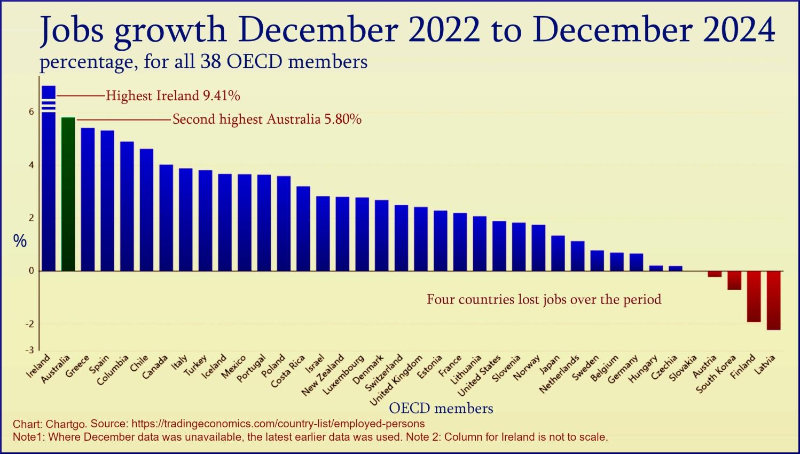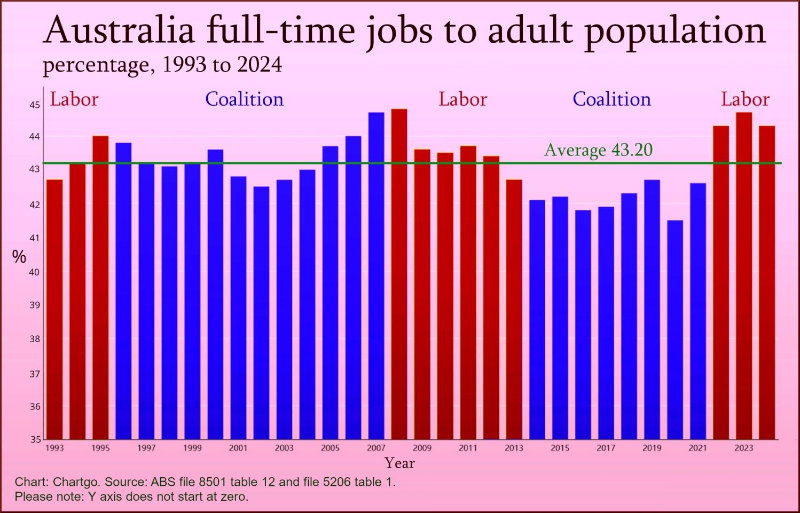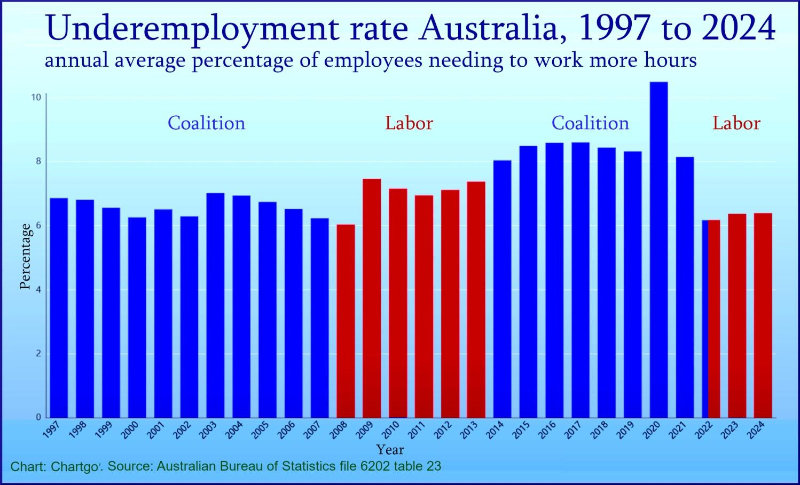
While the pundits focus on next week’s interest rate move by the Reserve Bank, the job market is the strongest it’s been for a long time. Alan Austin reports.
The latest figures from the Bureau of Stats (ABS) show the workforce has expanded by more than 3% in each of the last three years. This is unprecedented since the Bureau began keeping records.
Those rises were 3.35% in 2022, 3.19% in 2023 and 3.15% last year. That expansion of 1.38 million new workers in three years may well be the greatest in the developed world, relatively speaking.
That this has happened without a blow-out of the jobless or even a dip in the participation rate is quite remarkable.
The only other time Australia registered two straight years of workforce expansion above 3% was in 1986, when the jobless rate was 8.36% and the participation rate (see below) a mere 61.93%.
More jobs for more applicants
Of the extra 919,500 Australians in the workforce in just the last two years, the vast majority went into paid jobs.
According to the data at Trading Economics, only four of the 46 nations comprising the Organisation for Economic Cooperation and Development (OECD) and the G20 enjoyed employment growth over those two years above 5% – Ireland, Australia, Greece and Spain. Australia ranked second.

Australia’s jobless rate has remained below 4.25% for the entirety of the Albanese Government and, in total, for 37 months. That has not happened since ABS records began in 1966. The female jobless rate has been below 4.1% throughout the current term, also a first.
December’s unemployment rate of 3.98% now ranks ninth in the OECD. That’s up two places from the previous year, easing ahead of the Czech Republic and, for the first time ever, Norway. That compares with ranking 23rd in June 2020.
Jobs by Prime Minister
The tussle between political parties over which administration generated more jobs is no longer close. Albo is streets ahead.
These are the rankings on jobs created per year as a percentage of employed workers:
| Anthony Albanese: | 3.13% |
| Bob Hawke: | 2.48% |
| John Howard: | 2.37% |
| Malcolm Turnbull: | 2.31% |
| Paul Keating: | 2.02% |
| Scott Morrison: | 1.93% |
| Kevin Rudd: | 1.60% |
| Julia Gillard: | 1.44% |
| Tony Abbott: | 1.35% |
| Malcolm Fraser: | 0.83% |
Surge in full-time jobs
Full-time jobs as a percentage of the adult population hit a 34-year high annual average of 44.74% in 2023. Last year’s 44.30% was almost as strong. The last three years have all exceeded 44.30%, well above the long-term average of 43.20%. The Coalition averaged just 42.14% in its recent eight-year reign.

The flip side of this is the underemployment rate – the proportion of the labour force with jobs but working insufficient hours for a satisfactory income.
Through the recent Coalition period, this fluctuated between 7.5% and 13.0%. It has now settled between 5.8% and 6.7%.

Participating in the economy
For some decades the difficulty of finding a job discouraged potential workers from even signing up to look for one. This was quantified by measuring all workers plus job seekers as a percentage of the population – and called the participation rate.
This fluctuated between 62 and 65% through the Howard years and between 64 and 66% during the more recent Coalition period.
Those days appear gone. The participation rate hit an all-time monthly high of 66.71% in March 2023, then two more record highs later in 2023. Last year, this reached three all-time records, including December’s 67.13%.
The figures also show that there are more jobs for 15 to 24-year-olds.
Youth and young adult unemployment was 9.05% in December, with the rate steadily declining. This has been below 10% for the last nine months. That compares with the 12.49% average through the Turnbull period and 12.02% under Morrison.
Debunking jobs myth
Canadian economist David Card won the Nobel Prize for economics in 2021 for demonstrating that raising minimum wages doesn’t cost jobs and that immigration doesn’t lower incomes of native-born workers.
He and other Nobel laureates, including Claudia Goldin, Paul Krugman, and Joseph Stiglitz, have claimed – controversially – that governments directly shifting wealth and income from the top to the bottom is actually constructive in achieving desired economic outcomes for all citizens.
It’s hard to find a better example of Card’s theories in practice than Australia under Albanese and his treasurer, Jim Chalmers.
They have aggressively increased pensions and benefits, pushed for higher minimum wages, shifted the tax rates in favour of low-income workers, made it easier to prosecute wage thieves, handed cash to families to help pay energy bills and employed more government workers in strategic sectors. All while allowing high migrant inflows. This is Card’s fever dream.
Results include two budget surpluses after 14 straight deficits, record corporate profits, record export revenues, and a current boom in sales of luxury items, dining out and overseas travel.
That said, there is still much work to be done to reduce the overall cost of living, halt the ever-increasing housing costs and reduce inequality.
Australia is now the only economy in the world in budget surplus, with triple-A credit ratings and continual GDP growth for the last ten straight quarters. It is also the world’s only economy with a jobless rate below four percent, inflation below three percent, and median wealth per adult above US$250,000.
Wealth inequality. Housing cost is hollowing out middle Australia







